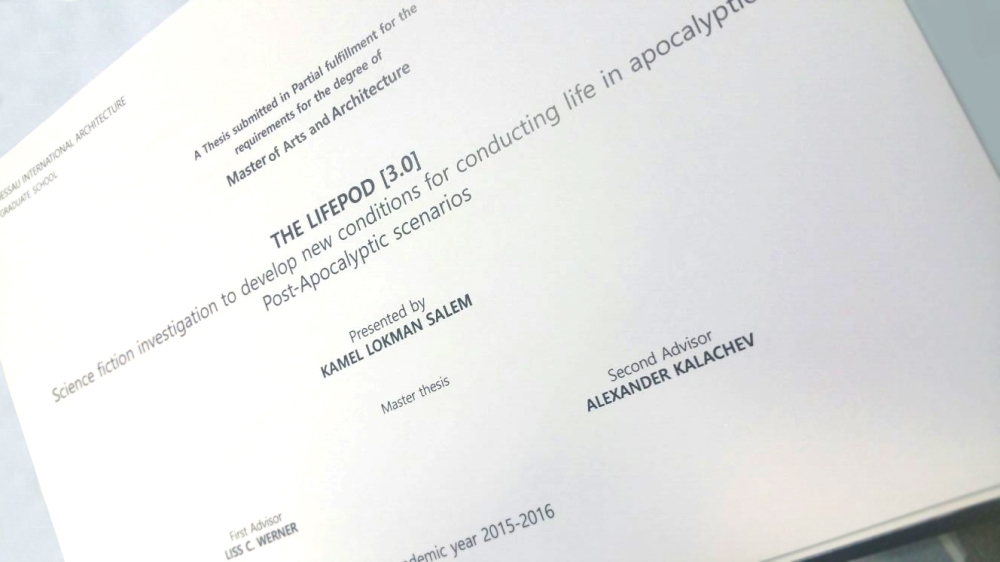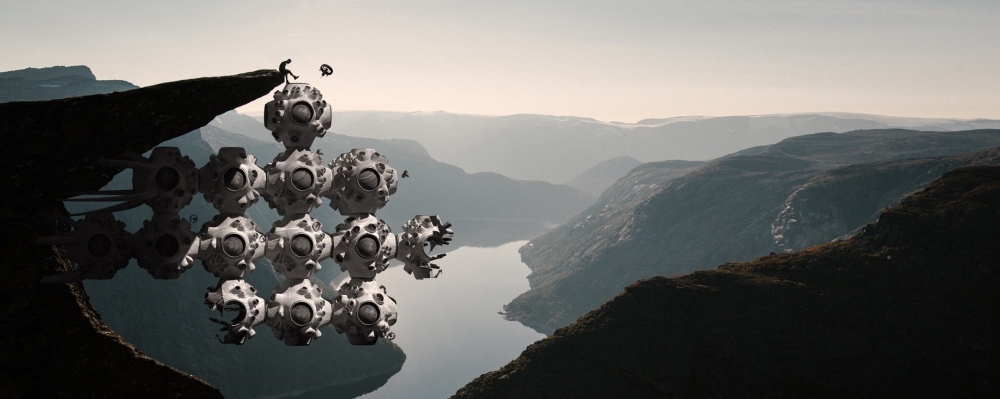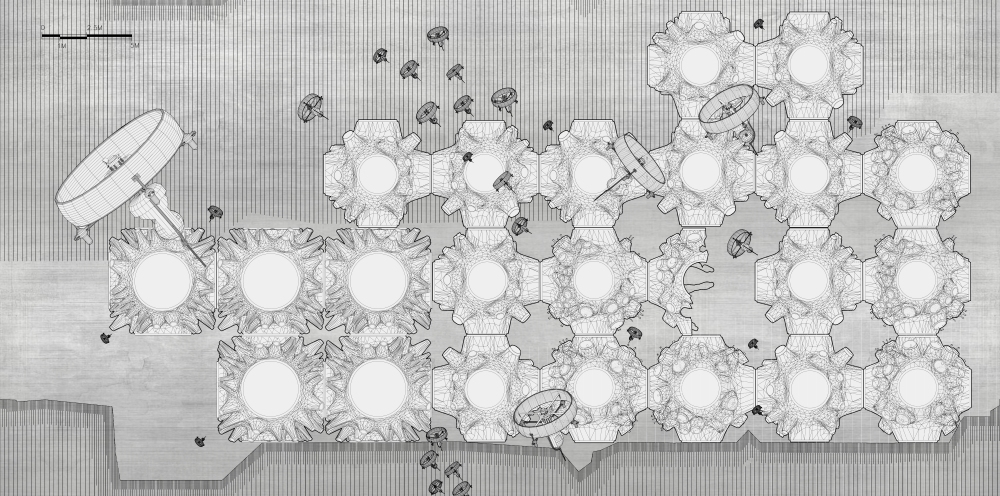
THE LIFEPOD [3.0] Science fiction investigation to develop new conditions for conducting life in apocalyptic and Post-Apocalyptic scenarios


Based on a huge amount of data consistently reinforcing predictions of impending climate and future natural disasters, the attention given to all things urban from the civil communities, engineers, and scientists is more than justified. But this has not always been the case. After radical architects have been trying the vision of the future city, examples of abstract visions decreased. Nevertheless, it is clear we need to re-imagine the world, because with the extreme progress of the technology the predictions are easier now. With the high level of predictability that urban data provides, it is then a bit surprising that climate change dominates the agenda of the future of the planet.
With an increasing urgency, we are being asked to imagine how we might live on a new planet full of crises, probably hotter, and more urbanized, especially after a lot of science fiction movies and novels which are discussing the apocalyptic and post-apocalyptic event with very tactile ways. All of this we can reliably predict. However, hopefully, just as the visions for urban life appear to be skinning, design professions are wading in to explore the depth of new possibilities. In this current now and new looks at the world with a new viewing scope.
The world has long been a project of our interpretation, imagination and assembly. The way we have managed and communicated our lengthy contemplation of the world has been through imagery.
The project approach is a visually and intellectually engaging exploration of the vision of a future where wars and environmental threats are growing and becoming facts, there is a shortage of any necessary resource, and our focus as a species is sustainability. But far from presenting a vision of Utopia, this project demonstrates a “possible future” with real and viable alternatives to our current patterns of militarism, commercialism, and disasters.
“the best way to predict the future is to create it” Abraham Lincoln

Apocalyptic sci fi images have been arranged to show our future. It does not matter too much whether this is true or not (and I take it to be true) because the crisis translates into two questions:
– What will be the source of energy for the future city
– How will we save billions of people living in suitable urban conditions?
Even more importantly, this crisis can be summarized in one issue: the need to invent new ways for us to live together and to save the human race; for this, we need new visions although we are always dependent on our beginning to generate images of these visions.
Describing this process of world changed, and what might become, imagery is the well-established means by which we depict our imaginings off the permanent present, and how we might go about change. There is a trajectory in this imagery to which go into virtual reality makes a significant contribution.

I am going to explain this project. It is composed of two related parts projected in 3D. It presents a new way of seeing the world; how it changes our way of thinking about the world and, as a result, might change the world itself. The concept of change drives the modern project.
In Barbara Stafford 1 essay Thoughts Not our Own: Whatever Happened to Selective Attention? Using advanced neurological research, puts a case for the way we comprehend. She concludes by stating, “Seeing, not seeing as, enables knowledge to grow… By changing the way (we think about (our thoughts, (we) can change (our brains as well as the world.’ Because we can imagine change, change takes place.
[1] Barbara Maria Stafford is an art historian whose research focuses on the developments in imaging arts, optical sciences, and performance technologies since the Enlightenment.
The net result is to design new future scenarios for the world. This requires new ways to imagine the world, not just as an ongoing real estate opportunity, but as the setting for new ways to be to get new conditions for conducting life in close margins, in my project principles of having new habitat fabric visions dependent on the conditioning principles of both utopia and the ideal city.

How we see the world has gone through several transitions (Growing behaviour) , as a result of changing philosophies and technologies which the critique of the city has for several ages, taken the form of a projection that serves to illustrate a possible future with better human condition.
What was once an accepted medium to criticize environmental, social, political, and cultural conditions and crisis has become an almost universal model for the development of new cities. Since the late nineteenth early twentieth century, there have been two seismic shifts in the conception of utopia: its idealized world became transfigured into science-fiction, and its idealized space was grafted onto the urban planning imagination ( seducing us into attempting the construction of ideal cities as utopias ).
From its invention, utopia has almost always been described and depicted as an island. When, in the 1960s, we saw for the first time the photographic image of our blue planet, it was described as an island floating in space. This image spawned environmental movements that alerted us to our stewardship of the planet.
While this global perspective wasn’t on More’s radar when he described his island, it is very plausible that the concept of the island called Utopia is in fact the island we call Earth. this is the case, stewardship has never been more taxed.
While the plan has been so tempting means by which to propel change, the curious absence in the imagery has been the elevation. Its absence could easily be explained by scale. Nevertheless we all experience the city through be essential to the future of the photography gave us record of moving through the documentary capacity presented both idealized city-scapes and the bleak reality of urban conditions–the utopian and dystopian. The photographic image has a long history and role in how record and imagine the world.
Around the same time that photography was emerging, the industrial revolution split idea from manufacture and turned the imagination of change into an image. What might become was therefore given its first imagination. However, because those doing the imagining did not control the production, our imaginings could only be an image of a possible future, Thus, both ideas of the growing future and images were locked in the permanent present of the everyday.

From that split, change has now become a virtual world, full of floating images with no there. The abundance of images in the digital flows that might refer to the possible future scenarios of our imaginings are now the floating images of no place that is everywhere.
Given that digital imagery represents new condition of the everyday, the photograph has changed its function-from an index of conditions to a conditioning tool. Instead of a representation of conditions, it is now a condition of representation. Its use visions for the future city is compromised.
Evolving from photography, cinema has used the narrative device of distance (borrowed from literary theory) to manipulate the reliability of information that we comprehend. In this way, film has adapted its form to comfortably depict both utopia and dystopia. Films derived from the literary genre of science fiction have given us a persuasive picture of the future city. Able to blend plan, elevation, and projection, fiction has literally transfigured the city.
Throughout the evolution of our thinking on urban settlement, we have used projections of future possible scenarios to document the change in how we see the world. All of the above methods and technologies illustrate our history of seeing which only permits as, us to transform what we know. But we are confronting a situation where the reliability of knowledge is now questionable that if the planet is self-regulating, then our capacity to imagine change will have to be a response to the planet’s changes.
Changing the way we think will require us to change the way we see. This is what Now And When contributes By inventing new ways to apply 3D projections, it changes the way we think we see the world. As such ,we might be able to change the way we think, as well as the way we change the world. Quite simply and very importantly, these 3D projections permit us to see what we don’t know presents a new way of seeing the world–in both its relationship to us and the planet-from the bottom up. It presents new visual descriptions of the world. These are typically graphic, dreaming, floating, connecting, eroded, saturated, calculating, glimmering, rhetorical narratives. They are derived from the biology and sediment of the utopia, because that is the only robust and reliable form we have for this demanding project.
The graphic predictions for this century do not demand new cities or new urban scenarios. Rather, they ask us to design new living models, new ways of being together; generating new ways of seeing through new types of imagery is essential to create new platforms for knowledge, from which we will understand how to respond to the planet. It makes a major contribution to how we see the world. Like the concept of utopia (which is not about the ideal location but the location of the idea) projects ideas about locating our future.
it was the discovery of fire that originally gave rise to the coming together of men, to discover , to know new stories, and to socially interact.
And so, as they kept coming together in greater numbers into one place, and from this time till now the architects made progress by gaining more expertise and experience in building design and the form finding methods on a daily basis, and as their creativity was increased by their skills.
“All the applications which are expressing the futuristic architecture are still not convincible in our present, and I think we still in the very beginning of designing the future, or by another hand it goes very slowly” .
Parametric Explained – Neil Leach

And after all of these architecture trials, how can’t one find himself naturally in his environment?!
And why is he trying to camouflage to survive?!
but on the other hand he can find himself with a virtual intelligence system…
Or he can find himself in a science-fiction story which has the time and the environment he needs…
Or he can feel secure regarding the future threats…
Or thinking about how robots can help the next generations…
but on the other hand he can find himself with a virtual intelligence system. Or he can find himself in the movie which has the time and the environment he needs.
How could the Science Fiction with the technology make us live a different life or a way of immerging & helping us becoming a part of that world? Achieving things beyond our imagination.
Not only is reality taking a page from fantasy when it comes to brain science, some of the experiments have actually been inspired by movies.
Steve Ramirez, the neuroscience PhD student responsible for an insane recent experiment that successfully implanted memories in the brains of mice, stated in an interview, “We began touching on these ideas mainly because all of us are huge fans of movies like ‘Inception, ‘and the ideas behind movies like ‘Total Recall’ and ‘Eternal Sunshine’ or ‘Memento.’
Therefore I can say that there is no solid way or at least an exciting outcome which can express the architecture and especially the futuristic architecture yet expect what we see nowadays by technology mixing with Science Fiction .
The LifePod
Many years ago, a race of hyper intelligent, let us designing computers, hyper computers, and robots, those pan-dimensional beings got so fed up with the constant information about the meaning of life, surrounds, environment, and human being.
“ so why not we commission one of those brightest and best to design robotic creature to build a stupendous supercomputer to calculate the answer to future life, A robot that will calculate the ultimate question. A robot of such infinite complexity, that future itself will form part of its operational matrix creating more primitive forms using the a ballooning amount of available data consistently reinforcing future predictions ,and go up into the best driving navigation for the human race next the 10-million-year.
“ Robotic prototype works as humans host “or protective shell”
and in the same time has ability to store and analysis the life information database.
Also the robot can build the same copy from itself to be used for the same reason with the same functionality but more self-upgraded through the time, using recycling materials such as carbon fibers or other to reduce the impact of dioxide or any other natural negative effect.
“ The robotic prototype works as humans host “or protective shell” and in the same time has ability to store and analyses the life information database.
Host Build Live Protect

Research The cells growing Matrix is a cloud of interlinked cells that accumulated to make a colony skin with lightweight and strength skeleton build from the available row materials such as Carbon fibers, different types of sand, crystals, some types of recycling metal such as Aluminium…etc, by using a robotic mechanisms distributed absorbent pipes on the outer surface that suck raw materials and water from the surroundings.

Also the robotic mechanisms distributed the microprocessors, arrays of sensors which is playing the main rule for collections the environment information to calculate what is needed for the new cells such as temperature, pressure, humidity., ..etc and with planting an AI system and Database control motherboard to can memory alloy actuators providing the best scenarios of concentrating the new structural clone and the assembly method with the whole also the robotic system plant a piezoelectric crystals and Photovoltaics crystals on the outer skin in order to harvest any optional source of energy.

The cells also contain slots that accommodated drones work as a distance sensors, data collectors and carriers. Each cell contained 2 main containers one work as spherical water storage container which can store and supply water to the cell, and in the same time works as a liquid balancing systems fixed in between the internal and the external skin of the Life Pod in order to create an self-stability that the fluid help Cell to save its position automatically, also as an circular inclined hydroponics system uses natural water irrigation from recycled rain water to give nutrition to the hosts.

and the other container is a recycling container for the organic waste which can be used for growing food afterwards. Each cells powered by a battery which can store any potential source of energy that could be collected such as wind energy , movement and vibration energy , and sun energy , etc.